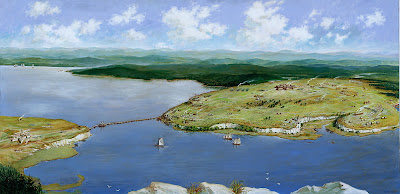 A partnership of state and non-profit entities has won an important award for its project to educate Vermonters about the history and archeology of the Lake Champlain area as part of the Lake Champlain Quadricentennial.
A partnership of state and non-profit entities has won an important award for its project to educate Vermonters about the history and archeology of the Lake Champlain area as part of the Lake Champlain Quadricentennial.
At its recent annual conference, the American Association for State and Local History awarded the Lake Champlain Voyages of Discovery project a 2010 Leadership in History Award of Merit.
“This is a special honor, and I’m grateful for the opportunity to accept the award on behalf of the partnership,” said project director Elsa Gilbertson, Regional Historic Site Administrator for the Vermont Division for Historic Preservation, which collaborated with Vermont Public Television- the Bixby Memorial Free Library in Vergennes- Broadwing Productions- and the University of Maine at Farmington Archaeological Research Center.
“I’m very proud of the Voyages project and pleased to see the work of so many people in Vermont being recognized at the national level,” said AASLH Council President David Donath, CEO of the Woodstock Foundation and member of the Vermont Advisory Council on Historic Preservation.
The two-and-a-half year project was funded by a $250,000 grant from the Institute of Museum and Library Services (IMLS) as well as matching resources from the partnership, and used the 400th anniversary of Samuel de Champlain’s arrival in Lake Champlain as an opportunity to explore and bring to life the little known but internationally significant area and its peoples from 1609 to the 1760s.
“This project was a multi-disciplinary effort using archeology, historic research, film-making, museum and library outreach, and extensive local and regional participation,” said Giovanna Peebles, State Historic Preservation Officer and head of DHP. “I think it did a terrific job of portraying the Native American and other peoples and their contributions to regional and world history during this critical period in the Champlain Valley.”
It included:
* An archeological investigation with professional archeologists, educators, and volunteers at the DAR State Park in Addison to look for traces of the French colonial past-
* A Lake Champlain Voyages of Discovery publication for the general public about this early history and archeological results-
* A one-hour documentary, Champlain: The Lake Between, by film maker Caro Thompson and Broadwing Productions with Vermont Public Television, which won a New England Emmy-
* Public programs and exhibits at the Chimney Point State Historic Site and Bixby Memorial Free Library-
* A special edition Champlain: The Lake Between, with “Classroom Connections” educational activities and resources distributed to schools in the Lake Champlain Basin of Vermont and New York-
* Educational kits and new books and other resources at the Bixby Memorial Free Library-
* A website with information about the project.
The AASLH Leadership in History Awards, now in its 65th year, is the most prestigious recognition in the United States for achievement in the preservation and interpretation of state and local history.
“The winners represent the best in the field and provide leadership for the future of state and local history,” said AASLH President Terry L. Davis.
DVDs of the Champlain: The Lake Between are available from Vermont Public Television by calling (802) 655-5307 and the special educational edition and the publication, Lake Champlain Voyages of Discovery, are available from the Chimney Point State Historic Site.
Educational kits are available in the local area on loan from the Bixby Memorial Free Library. For more information, visit: www.historicvermont.org/imls/lakechamplainvoyageshomepage.html
“VPT is proud to be part the Voyages of Discovery project, making this valuable content available to classroom teachers, students and lifelong learners,” said Vermont Public Television president John King.
Vermont Public Television will re-air Champlain: The Lake Between on Monday, Oct. 18, at 10:30 p.m.
![]() Author Willard Sterne Randall will give a talk on Ethan Allen, one of Vermont’s best known historic figures, on June 18 at 1 p.m., at the Mount Independence State Historic Site in Orwell, VT. Randall’s new book, Ethan Allen: His Life and Times, which W.W. Norton will be coming out with later this summer, is the first comprehensive biography of Allen in a half century.
Author Willard Sterne Randall will give a talk on Ethan Allen, one of Vermont’s best known historic figures, on June 18 at 1 p.m., at the Mount Independence State Historic Site in Orwell, VT. Randall’s new book, Ethan Allen: His Life and Times, which W.W. Norton will be coming out with later this summer, is the first comprehensive biography of Allen in a half century.





